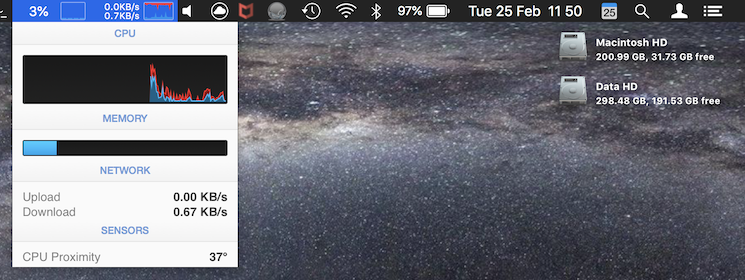

- #Menumeters alternative mojave full#
- #Menumeters alternative mojave pro#
- #Menumeters alternative mojave software#
- #Menumeters alternative mojave mac#
For those which were available for checking, like the Recovery volume, it reported that it only performed a ‘QUICKCHECK’, and that the file system was ‘CLEAN’.
#Menumeters alternative mojave full#
Its fsck_apfs log and unified log were active throughout the period of the Safe boot, but show no evidence of performing any full fsck_apfs check and repair on any of the accessible volumes. The MacBook Pro, running Catalina without Time Machine, booted as quickly in Safe Mode as it does normally. Safe Mode in Catalina without Time Machine The unified log is a complete blank for the period:ġ0:07:10.076313 TIC TCP Conn Event : 7ġ0:07:11.036891 = system wallclock time adjustedġ0:36:21.785491 Sandboxing init issue, couldn't find profile in default paths, attempting default compiled profileġ0:36:21.793885 Sandboxing init issue resolved: "Success"ġ0:36:22.285930 = system wallclock time adjustedġ0:36:22.332823 event logs in /.fseventsd out of sync with volume. The fsck_apfs log in /var/log only records quick checks which occurred before starting up in Safe Mode, and those performed afterwards. As it didn’t restart automatically, I must presume that no APFS directory repair was performed.Īll attempts to find any record of what happened during that period of thirty minutes have failed. After all that, there isn’t any evidence that it checked any disks or snapshots, although given how long it took, I can only presume that it did run fsck_apfs on the boot disk, and that it trudged through each of the snapshots it could find. The iMac Pro, running Mojave and Time Machine, took half an hour – yes, 30 minutes – to start up in Safe Mode, requiring two separate logins, the first to unlock its T2-encrypted internal SSD at the start, the second half an hour later to log on as the user.
#Menumeters alternative mojave pro#
The other is my Catalina test system, a MacBook Pro 2017 without Touch Bar (no T1/T2 chip) running Catalina 10.15, with an external 750 GB SSD but no Time Machine or backups, so probably no snapshots either.īoth systems seemed to accomplish objectives 2 and 3 above just fine, but disk checking and repair remain a mystery. One’s an iMac Pro running fully updated Mojave with Time Machine active, and a couple of dozen snapshots accessible as well as the backup drive, and external RAID in HFS+. I’ve now put both my active Macs into Safe Mode. It also doesn’t mention checks on other mounted volumes, or on APFS snapshots.
#Menumeters alternative mojave mac#
If the directory is repaired, your Mac automatically restarts.” I note the carefully chosen words “similar to”, which isn’t the same as “the same as”, and specific reference to directory checking and repair, which is more limited than a full fsck_apfs. This is similar to what happens when you use Disk Utility to verify or repair your disk. Of course, that should be easy to answer by trying it then browsing the fsck_apfs log in /var/log.Īccording to Apple, “Your Mac automatically checks the directory of your startup disk when you start up in safe mode. If you’re trying to isolate a problem which affects one of those sub-systems, Safe Mode won’t help.īut the question which was raised here was whether Safe Mode performs a full check and repair of your boot disk, in the way that would be performed by starting up in Recovery Mode and running First Aid in Disk Utility. The second of those limits its usefulness, as some of the blocked items prevent some sub-systems from working normally. it deletes font caches, the kernel cache, and other system caches.

#Menumeters alternative mojave software#
Safe Mode was a useful tool when things started to go awry: there was something not quite right, possibly a software conflict, and starting up with the Shift key held gave you a chance to isolate the problem.


 0 kommentar(er)
0 kommentar(er)
